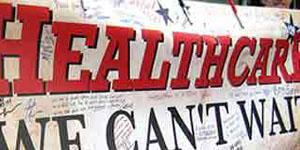A recent poll reveals that most Americans don’t know what in health care reform’s name the public option is—less than 4 in 10 can accurately describe it.
Is this supposed to be surprising?
After all, the health care debate has been dominated much more by town hall hysteria and death panel talk than actual substance. For all the buzz about public option bickering—Pelosi v. McCain v. Obama v. Grassley!–politicians and the media have provided scant information about how exactly it would work or the impact it would have.
So…what is the public option?
The text of America’s Affordable Health Choices Act of 2009 describes it as:
(a) Establishment- For years beginning with Y1, the Secretary of Health and Human Services (in this subtitle referred to as the `Secretary’) shall provide for the offering of an Exchange-participating health benefits plan (in this division referred to as the `public health insurance option’) that ensures choice, competition, and stability of affordable, high quality coverage throughout the United States in accordance with this subtitle. In designing the option, the Secretary’s primary responsibility is to create a low-cost plan without comprimising quality or access to care.
(b) Offering as an Exchange-participating Health Benefits Plan-
(1) EXCLUSIVE TO THE EXCHANGE- The public health insurance option shall only be made available through the Health Insurance Exchange.
(2) ENSURING A LEVEL PLAYING FIELD- Consistent with this subtitle, the public health insurance option shall comply with requirements that are applicable under this title to an Exchange-participating health benefits plan, including requirements related to benefits, benefit levels, provider networks, notices, consumer protections, and cost sharing.
(3) PROVISION OF BENEFIT LEVELS- The public health insurance option–
(A) shall offer basic, enhanced, and premium plans; and
(B) may offer premium-plus plans.
For more information, Time magazine did a handy, clear-cut breakdown of the public option and co-ops, which Obama has flirted with including instead. CNN answered “What’s a public health plan anyway?” And our very own Kevin Drum gives his take here.
Happy learning.













